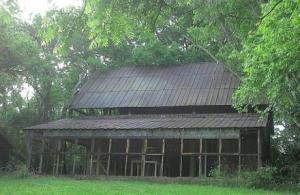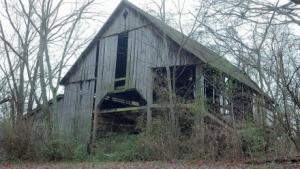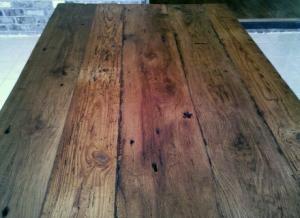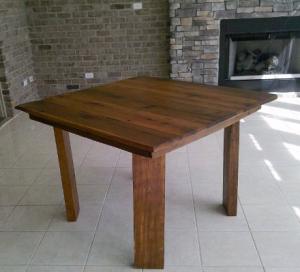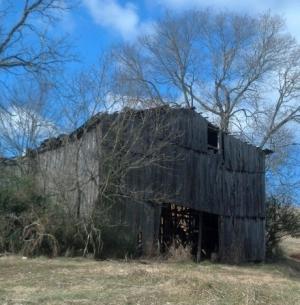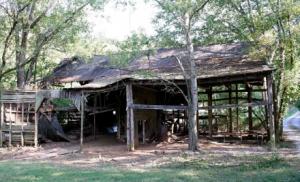By Nancy Brannon, Ph.D.
Materials from old barns are becoming more and more popular for use as design features in new homes, renovated homes, and in art work. Ray Trotta founded the Tennessee Barn Wood Company, Knoxville, Tennessee, in 2010 to preserve these pieces of American history by dismantling dilapidated barns and repurposing the salvageable barn wood. Rustic barn wood can be converted to furniture, floors, paneling, and variety of other uses in modern homes.
Ray didn’t start out as a carpenter or a demolition expert; he was working for an accounting firm when he started. But he learned by doing, and now his expertise is in knowing how to take down a barn safely. Called by some the “barn whisperer,” Ray says he “listens to the barn as he works on it. The barn and I come to an understanding. The barn has lots of people’s energy and I can feel that energy. It’s a rewarding feeling know3ing that what could be a liability to a property owner, can be saved and repurposed to a new life.” He has reached the point where is ready to teach someone else what he has learned about taking down old barns.
Ray is a historian by education (from UT), so he enjoys finding out the history of these structures. “I get to know the people and do the research on the structures.” Ray says that the “average age of barns in the mid-south ranges from the 1920s to 1950-1960 models. These barns were all built on the knowledge of the people who built them and the available resources. The barn was the center of the farm’s existence, a place to protect cattle, equipment, and crops. But mechanization of farming changed the nature of farms and made a lot of these old barns obsolete. Many are too small to use for storing today’s large farm equipment.” A lot of the old barns he finds used to be tobacco barns, but the farmers were put out of business or paid not to grow the crops. “The average age of these old barns is 80 years. On one barn, the wood from the barn was said to be 60 years old, but that wood had been part of another structure before it was a barn.”
Ray’s first project was dismantling the Turner Barn off Badgett Road in west Knoxville. The barn was originally built in the late 1890s. He knew the wood would be valuable, but he didn’t know exactly where it would go. So he started making tables out of the wood. Then he gradually moved into the lumber business. Now he sells the salvaged lumber to contractors, interior designers, architects, homeowners, and artists who use the wood for accent in interior rooms. The tedious work is in de-nailing the boards, sorting, and stacking the lumber by species.
One of the rare woods that he sometimes finds is Chestnut. “That wood is not available anymore. A disease in the 1900s wiped out all the chestnut trees in the country.” Oak is the most prevalent wood, and he often finds hand hewn beams, 6x6 or 8x4 feet. “It’s so dense it weighs about ten pounds per foot,” he said.
Ray finds nearly every part of the old barns useful, not just the wood but also the old roof tin and old nails. Trotta often finds antiques and collectibles in old barns, such as pulleys, barn doors, antique windows, nails, hinges, and, of course, weathered roofing tin. The metal has a scrap value of about $200 - $300, but can sell for $2,000 to $3,000 if he stores if and it’s repurposed. He sells 2x8 or 2x12 foot sheets that are used to accent the barn wood in homes. “The rust oxidized on the top and it doesn’t come off; it’s baked on there. The metal gets so hot on the barn roof over 20 years or more and turns a reddish brown, developing a patina,” he said. The grey siding is his most desirable product. “It works best when mixed with brown and reddish brown interior wood,” he said. Some of the materials are used in “man caves;” the old barn tin works great for ceilings.
Some of his other projects were the Meyers Barn in Townsend, TN, built in the 1930s; the Lewis Dairy Barn, built in the 1880s and found within the city limits of the Fountain City section of Knoxville. A Madisonville, TN barn and the Yellowjacket Barn in Maryville, TN both yielded some great wood. His latest project is the Campbell Barn of Lone Mountain and Straight Creek Road in Claiborne County, TN.
Trotta says he is “really happy working for myself. I have a lot of energy and I get excited when I’m doing what I like. I find the process of learning very stimulating!” Find more information at: http://www.tennesseebarnwood.com/ or on facebook/tennesseebarnwood.
Materials from old barns are becoming more and more popular for use as design features in new homes, renovated homes, and in art work. Ray Trotta founded the Tennessee Barn Wood Company, Knoxville, Tennessee, in 2010 to preserve these pieces of American history by dismantling dilapidated barns and repurposing the salvageable barn wood. Rustic barn wood can be converted to furniture, floors, paneling, and variety of other uses in modern homes.
Ray didn’t start out as a carpenter or a demolition expert; he was working for an accounting firm when he started. But he learned by doing, and now his expertise is in knowing how to take down a barn safely. Called by some the “barn whisperer,” Ray says he “listens to the barn as he works on it. The barn and I come to an understanding. The barn has lots of people’s energy and I can feel that energy. It’s a rewarding feeling know3ing that what could be a liability to a property owner, can be saved and repurposed to a new life.” He has reached the point where is ready to teach someone else what he has learned about taking down old barns.
Ray is a historian by education (from UT), so he enjoys finding out the history of these structures. “I get to know the people and do the research on the structures.” Ray says that the “average age of barns in the mid-south ranges from the 1920s to 1950-1960 models. These barns were all built on the knowledge of the people who built them and the available resources. The barn was the center of the farm’s existence, a place to protect cattle, equipment, and crops. But mechanization of farming changed the nature of farms and made a lot of these old barns obsolete. Many are too small to use for storing today’s large farm equipment.” A lot of the old barns he finds used to be tobacco barns, but the farmers were put out of business or paid not to grow the crops. “The average age of these old barns is 80 years. On one barn, the wood from the barn was said to be 60 years old, but that wood had been part of another structure before it was a barn.”
Ray’s first project was dismantling the Turner Barn off Badgett Road in west Knoxville. The barn was originally built in the late 1890s. He knew the wood would be valuable, but he didn’t know exactly where it would go. So he started making tables out of the wood. Then he gradually moved into the lumber business. Now he sells the salvaged lumber to contractors, interior designers, architects, homeowners, and artists who use the wood for accent in interior rooms. The tedious work is in de-nailing the boards, sorting, and stacking the lumber by species.
One of the rare woods that he sometimes finds is Chestnut. “That wood is not available anymore. A disease in the 1900s wiped out all the chestnut trees in the country.” Oak is the most prevalent wood, and he often finds hand hewn beams, 6x6 or 8x4 feet. “It’s so dense it weighs about ten pounds per foot,” he said.
Ray finds nearly every part of the old barns useful, not just the wood but also the old roof tin and old nails. Trotta often finds antiques and collectibles in old barns, such as pulleys, barn doors, antique windows, nails, hinges, and, of course, weathered roofing tin. The metal has a scrap value of about $200 - $300, but can sell for $2,000 to $3,000 if he stores if and it’s repurposed. He sells 2x8 or 2x12 foot sheets that are used to accent the barn wood in homes. “The rust oxidized on the top and it doesn’t come off; it’s baked on there. The metal gets so hot on the barn roof over 20 years or more and turns a reddish brown, developing a patina,” he said. The grey siding is his most desirable product. “It works best when mixed with brown and reddish brown interior wood,” he said. Some of the materials are used in “man caves;” the old barn tin works great for ceilings.
Some of his other projects were the Meyers Barn in Townsend, TN, built in the 1930s; the Lewis Dairy Barn, built in the 1880s and found within the city limits of the Fountain City section of Knoxville. A Madisonville, TN barn and the Yellowjacket Barn in Maryville, TN both yielded some great wood. His latest project is the Campbell Barn of Lone Mountain and Straight Creek Road in Claiborne County, TN.
Trotta says he is “really happy working for myself. I have a lot of energy and I get excited when I’m doing what I like. I find the process of learning very stimulating!” Find more information at: http://www.tennesseebarnwood.com/ or on facebook/tennesseebarnwood.
